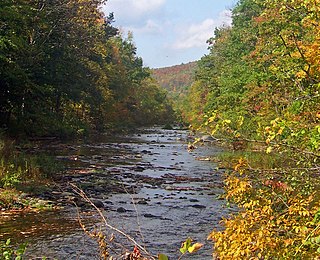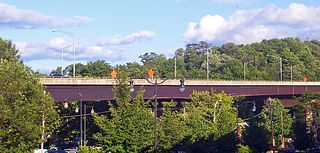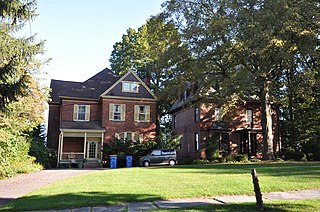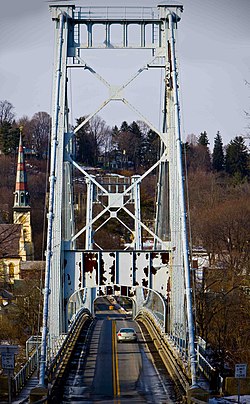
Esopus is a town in Ulster County, New York, United States. The population was 9,548 at the 2020 census. The town was named after the local indigenous tribe and means "small river" in English. This is incorrect. In the Lenape` language, the word translates to "Wellspring of Creation" They were one of the Lenape (Delaware) bands, belonging to a people who ranged from western Connecticut through lower New York, western Long Island, and parts of New Jersey and Pennsylvania along the Delaware River. The town is on the west bank of the Hudson River south of the city of Kingston. Its center is in Port Ewen. US Route 9W passes along the eastern side of the town.

Port Ewen is a hamlet in Ulster County, New York, United States. The population was 3,678 at the 2020 census. Port Ewen is in the Town of Esopus, south of Kingston, along U.S. Route 9W. Port Ewen is bounded by the Rondout Creek to the north, the Hudson River to the east, the hamlets of Connelly and Sleightsburgh to the northwest and northeast, respectively, the hamlet of Ulster Park to the south, and New Salem to the west.

Rosendale is a hamlet located in the Town of Rosendale in Ulster County, New York, United States. The population was 1,285 at the 2020 census. It was also a census-designated place known as Rosendale Village until 2010, when the U.S. Census Bureau designated it Rosendale Hamlet. Some maps continue to list the place as just Rosendale. As of 2020, the "Hamlet" in the CDP name was dropped.

The Delaware and Hudson Railway (D&H) is a railroad that operates in the Northeastern United States. In 1991, after more than 150 years as an independent railroad, the D&H was purchased by the Canadian Pacific Railway (CP). CP, which would itself become part of Canadian Pacific Kansas City in 2023, operated D&H under its subsidiary Soo Line Corporation, which also operates Soo Line Railroad.
The Ulster and Delaware Railroad (U&D) was a railroad located in the state of New York. It was often advertised as "The Only All-Rail Route to the Catskill Mountains." At its greatest extent, the U&D extended 107 miles (172 km) from Kingston Point on the Hudson River through the Catskill Mountains to its western terminus at Oneonta, passing through the counties of Ulster, Delaware, Schoharie and Otsego.

The Delaware and Hudson Canal was the first venture of the Delaware and Hudson Canal Company, which would later build the Delaware and Hudson Railway. Between 1828 and 1899, the canal's barges carried anthracite coal from the mines of northeastern Pennsylvania to the Hudson River and thence to market in New York City.

Rondout Creek is a 63.3-mile-long (101.9 km) tributary of the Hudson River in Ulster and Sullivan counties, New York, United States. It rises on Rocky Mountain in the eastern Catskills, flows south into Rondout Reservoir, part of New York City's water supply network, then into the valley between the Catskills and the Shawangunk Ridge, where it goes over High Falls and finally out to the Hudson at Kingston, receiving along the way the Wallkill River.

Rondout, is situated in Ulster County, New York, on the Hudson River at the mouth of Rondout Creek. Originally a maritime village, the arrival of the Delaware and Hudson Canal helped create a city that dwarfed nearby Kingston. Rondout became the third largest port on the Hudson River. Rondout merged with Kingston in 1872. It now includes the Rondout–West Strand Historic District.

Esopus Meadows Lighthouse, nicknamed "Maid of the Meadows" and often simply referred to as the Esopus Light or Middle Hudson River Light is an active lighthouse on the Hudson River near Esopus, New York. The lighthouse stands on the west side of the channel, in the river, its granite foundation built atop piles that have been driven into the riverbed, and is accessible only by boat.

The Wallkill Valley Rail Trail is a 23.7-mile (38.1 km) rail trail and linear park that runs along the former Wallkill Valley Railroad rail corridor in Ulster County, New York, United States. It stretches from Gardiner through New Paltz, Rosendale and Ulster to the Kingston city line, just south of a demolished, concrete Conrail railroad bridge that was located on a team-track siding several blocks south of the also-demolished Kingston New York Central Railroad passenger station. The trail is separated from the Walden–Wallkill Rail Trail by two state prisons in Shawangunk, though there have been plans to bypass these facilities and to connect the Wallkill Valley Rail Trail with other regional rail-trails. The northern section of the trail forms part of the Empire State Trail.

The Rondout–West Strand Historic District is located on the shore of Rondout Creek along the southern boundary of the city of Kingston, New York, United States. Formerly Rondout, New York, it is bounded by the creek, Broadway, Hone, Ravine and McEntee streets, an area of 570 acres (2.3 km²) containing 259 buildings, most dating to the 19th century. US 9W and the John T. Loughran Bridge are immediately to the east; the Kingston-Port Ewen Suspension Bridge crosses the creek to the west. The neighborhood is often referred to locally by either of the two names.

The John T. Loughran Bridge carries U.S. Route 9W (US 9W) over Rondout Creek between Kingston and Port Ewen, New York, United States. It also crosses over Ferry Street on the Kingston side. It is located just downriver from the historic Kingston-Port Ewen Suspension Bridge, which carried 9W until the Loughran Bridge was constructed. It is just upriver from where the Rondout empties into the Hudson River.

The Hudson River Maritime Museum is a maritime museum dedicated to the Hudson River.

The New York, Ontario, and Western Railroad Passenger Station is located on Institution Road, between Eastern Correctional Facility and Rondout Creek, near Napanoch, New York, United States.

Rondout Light is a lighthouse on the west side of the Hudson River at Kingston, New York.

Bridge L-158 is a disused railroad bridge over Muscoot Reservoir near Goldens Bridge, New York, United States. Built to carry New York Central Railroad traffic over Rondout Creek near Kingston, it was moved to its current location in 1904.

The former Kingston City Library building is located on Broadway in the center of Kingston, New York, United States. It is a brick Carnegie library built in 1903 in the Classical Revival architectural style.

Chestnut Street Historic District is a national historic district located at Kingston in Ulster County, New York. The district includes 44 contributing buildings and six contributing structures. It comprises a collection of substantial 19th and early 20th century residences on dramatic hillside sites. It also includes the Immanuel Lutheran Church and Bruck Funeral Home.

Kingston is the only city in, and the county seat of, Ulster County, New York, United States. It is 91 miles (146 km) north of New York City and 59 miles (95 km) south of Albany. The city's metropolitan area is grouped with the New York metropolitan area around Manhattan by the United States Census Bureau. The population was 24,069 at the 2020 United States Census.

The Rosendale Trestle is a 940-foot (290-meter) continuous truss bridge and former railroad trestle in Rosendale Village, a hamlet in the town of Rosendale in Ulster County, New York. Originally constructed by the Wallkill Valley Railroad to continue its rail line from New Paltz to Kingston, the bridge rises 150 ft (46 m) above Rondout Creek, spanning both Route 213 and the former Delaware and Hudson Canal. Construction on the trestle began in late 1870, and continued until early 1872. When it opened to rail traffic on April 6, 1872, the Rosendale trestle was the highest span bridge in the United States.




















